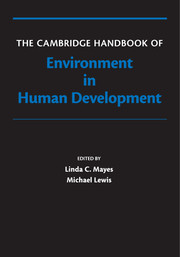Book contents
- The Cambridge Handbook of Environment in Human Development
- The Cambridge Handbook of Environment in Human Development
- Copyright page
- Contents
- Notes on Contributors
- The Role of Environments in Development:
- Part I The “Environmental” Variable
- Part II Contemporary Themes
- Part III Environments
- Chapter 10 Parental Care and Attachment
- Chapter 11 Understanding the Developmental Influences of the Family Environment
- Chapter 12 Measuring the Environments of Early Care, Education, and Intervention Programs for Children in Poverty
- Chapter 13 School Influences on Human Development
- Chapter 14 Siblings and Peers in the Adult-Child-Child Triadic Context
- Chapter 15 Neighborhood Environments
- Chapter 16 Rural versus Urban Environments
- Chapter 17 Poverty
- Chapter 18 Social Networks
- Chapter 19 Marital Health
- Chapter 20 Parental Psychopathology
- Chapter 21 The Environment of Children of Illicit Drug Users
- Chapter 22 Early Exposure to Trauma
- Chapter 23 Child Maltreatment
- Chapter 24 The Cultural Organization of Children’s Environments
- Chapter 25 Children and Electronic Media
- Part IV Measurement
- Index
Chapter 12 - Measuring the Environments of Early Care, Education, and Intervention Programs for Children in Poverty
from Part III - Environments
Published online by Cambridge University Press: 05 October 2012
- The Cambridge Handbook of Environment in Human Development
- The Cambridge Handbook of Environment in Human Development
- Copyright page
- Contents
- Notes on Contributors
- The Role of Environments in Development:
- Part I The “Environmental” Variable
- Part II Contemporary Themes
- Part III Environments
- Chapter 10 Parental Care and Attachment
- Chapter 11 Understanding the Developmental Influences of the Family Environment
- Chapter 12 Measuring the Environments of Early Care, Education, and Intervention Programs for Children in Poverty
- Chapter 13 School Influences on Human Development
- Chapter 14 Siblings and Peers in the Adult-Child-Child Triadic Context
- Chapter 15 Neighborhood Environments
- Chapter 16 Rural versus Urban Environments
- Chapter 17 Poverty
- Chapter 18 Social Networks
- Chapter 19 Marital Health
- Chapter 20 Parental Psychopathology
- Chapter 21 The Environment of Children of Illicit Drug Users
- Chapter 22 Early Exposure to Trauma
- Chapter 23 Child Maltreatment
- Chapter 24 The Cultural Organization of Children’s Environments
- Chapter 25 Children and Electronic Media
- Part IV Measurement
- Index
Summary
Keywords
- Type
- Chapter
- Information
- The Cambridge Handbook of Environment in Human Development , pp. 243 - 258Publisher: Cambridge University PressPrint publication year: 2012



